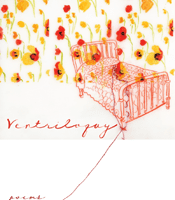Ventriloquy is a book of voices, images, sounds, colors, and sensations. Ventriloquy is also a book of ideas; ideas about seeing and hearing, how what is seen and heard can be rendered in text, and how those texts are implicated by the subjects and objects of acts of witness. From Plato to Nietzsche, Baudrillard to Benjamin, simulacra in forms of art and cultural production have been identified, defined, and redefined. In this ambitious collection, Athena Kildegaard systematically examines in the space of four poem sequences different forms of simulacra from a distinctly feminist perspective and poetic praxis. Her narrative gaze sweeps in scope from the vastness of the universe’s astronomical bodies to the tininess of flecks of pepper scattered across a kitchen table. Throughout, Kildegaard demonstrates a facility with energetically deconstructed syntax that is contrasted with a lush vocabulary full of oddments and double meanings.
The collection opens with “Gardens of Tongues, Gardens of Eyes,” a sequence of poems about flowers that reads like Edward Gorey meets Lewis Carroll with a gender twist. Here we meet with a kooky, whimsical sensibility personifying the residents of a magic garden in sonically playful anthropomorphisms of things both strange and ordinary. It may be obvious to point out that flowers are both yonic symbols and memento mori, and that all of the flower poems are written in the third person and present tense in a kind of poetic free and direct speech. What surprises as we read deeper, however, are the ways in which the narrative voice, in a nod perhaps to the art of ventriloquy, undercuts its formal, vaguely British, sometimes anachronistic tone and begins to code switch in the book’s second sequence, “Saints, Contrary and Futile (I).” There, individual poems mobilize lists of objects and word associations in a buoyant pared down language that builds meaning cumulatively and allusively. Notable poems from that section include “The Saint of Grace,” “The Saint of Oblivion,” “The Cloud Saint,” and “The Saint of Whimsy.”
In the third poetic sequence entitled “Divination,” we are introduced quite suddenly to a first person persona. By the time this occurs, the sense and weight of revelation that the “I” implies feels well earned. In “By Iron,” for example, the matter-of-fact Americanness of tone and linguistic convention signals a candor that matches its subject, which deals with the memory of a sexual experience with the speaker’s cousin.
…who would tell? He
kept secrets like some people keep lint. I didn’t
know the words. We stood there, wrenches along
my uncle’s workbench, my cousin’s cock iron stiff.
In “By Desire,” this sense of ambivalence and gravity is further realized in a sexuality that is presented in fractured, horrific parts.
… Or she would hold him as Salome
offered up St. John, his head open-mouthed,
on a platter. No, she’d hold his head,
alive, the tongue arced and silent.
In “By Ice,” one of the most powerful poems of the collection, we are given a snapshot of a mother and a daughter. The mother is dying. The daughter remains focused on details, seeking to freeze time. The pathos lies in an unadorned list of quotidian images: snow, geese, the motel, a lone glove frozen on gravel. The rest of the poems in this sequence deal with family, mortality, and sexuality in narratives that appear at first glance to be the most personal and confessional of the collection.
“Writing between the lines,” poet and literary critic Rachel Blau Duplessis posits, is a feminist act that calls attention to what is left unarticulated. As such, it is apparent that a rich subtext in Kildegaard’s more seemingly confessional poems is signaled by a tonal modulation from the impersonal to the personal that creates an impression of disclosure, a kind of break in the fourth wall of the established narrative. Whether or not these poems are actually autobiographical or truly confessional is of no consequence. What is far more interesting is the way in which this trope problematizes and complicates the notion of simulacra, and presents the reader with multiple layers of reproductions and performances.
In a fourth sequence of short prose poems depicting still life paintings, the ekphraistic is employed as a lyric mode in a final examination of art, language, and gender. Replete with collections of musical instruments, exotic and everyday foods, fruits, and flowers, these poems revisit and remix some of the key images and tropes of the previous sequences. Belying the directness of its title,“Still Life with My Mother, Dead Now Three Months” echoes the narrative focus of “By Ice” by training its eye on objects such as “a branch of gooseberries, prickly as anemones,” a vase, “one white lily,” and the painting that contains them, as if in a bid to assert control over grief with an adherence to the concrete world. Nonetheless, glimpses of uncertainty longing, and a possible afterlife are revealed in such lines as, “The painting could have wings; it could be rising,” and, “So much is hidden.” “Still Life with Universe” closes the book in a neat full circle by hearkening back to the astronomical imagery and flowers of the first poem “Lilies” with “peonies arcing from a white vase” recast as “comets caught naked in the night sky.”
As the poet Diane Seuss explains in a recent interview at The New England Review, historically, “still life was viewed as the lowest rung in terms of subject matter, offering neither the grand romance of history nor the elevation of gods and cherubs, but simply bowls, peaches, the carcass in the kitchen on its way to becoming food. The realm of women’s work, in other words.” Ventriloquy’s still life poems round out this strong, unapologetically feminist collection with both a commentary on how women’s art has been historically undervalued and a return to its central preoccupations: hunger, desire, mortality, visual pleasure, the minute, and the universal.





